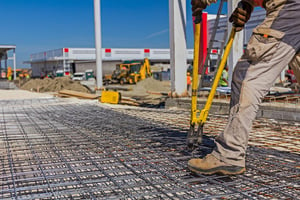
Let’s talk feet. The long-time ANSI Z41 standard changed not too long ago to the new ASTM 2413-11, the standard specification for Performance Requirements for Protective Toe Cap Footwear. The updated standard covers the testing and materials of protective toe footwear, with a few additional changes. It is designed to expand protective measures for the sole of the foot and delicate toe and metatarsal bones. You know, to avoid crushed feet.
Soccer and football players need to wear the right shoes, designed with different capabilities, in order to provide maximum results in their game. Workers, our very own industrial athletes, also need the right safety shoes for the job. The PPE they choose varies according to the features and benefits they can offer.
Let’s take a look at the common concerns related to footwear on the job:
- Protective Toe: A jobsite can change on an hourly basis. Protecting your feet from falling and flying objects with steel/composite toe boots or metatarsal guards can help prevent tools, machinery or other materials from crushing your feet.
- Puncture Resistant: Your head needs to be on a swivel when you are working in a dangerous environment, but sometimes accidents happen. Having puncture-resistant safety shoes can really save the day if you happen to step on a nail or drop something sharp.
- Slip-Resistant: Specially designed to address varying coefficients of friction between the floor or work surface and materials that may be present and how they move across each other. Very simply put, slip-resistant shoes keep your feet firmly on the ground no matter if you are battling moisture or happen to spill oil on the floor. For a great pair of slip-resistant shoes, check out these work shoes.
- Work Conditions: It’s also important to remember the conditions you are expecting your shoe to stand up to. Does your safety shoe come into contact with any base level acid that can damage the threading or the structure of the shoe?
Protective Toe versus Metatarsal Steel Toe:
Protective Toe: Basically, if you are on a job site or in a facility that involves nails, falling debris, heavy equipment or forklifts, you probably will be wearing a steel or composite toe boot. Many features are available in a protective toe, including slip- and puncture-resistance that can be useful in a variety of environments. These safety boots have you covered, check them out!
Metatarsal: Metatarsal bones (small bones of the feet and toes) have a tendency to break easily, take a long time to heal and there isn’t much we can do to speed the healing along. So, it only makes sense that we should allow for additional protection like steel toe metatarsal shoes to avoid injury to those delicate areas of the upper foot. Take a look at these work boots for the protection you're looking for…
Protective footwear can have many functions and features and many are made of space age materials that add flexibility and comfort, but it still MUST pass testing requirements that measure impact and compression. Protective toe or metatarsal shoes and guards are of no use to you if the safety shoe's integrity doesn’t hold up and collapses on your feet. Can it perform? Do your safety boots pass the drop test? If they don't, you can be looking at a long stretch of time laid up while your feet slowly heal. That sounds fun, doesn’t it?
Compression (C) & Impact (I) Test

* All footwear manufactured to this standard must be marked with the specific portion of the standard with which it complies.
Once a shoe passes the protective toe and metatarsal compression and impact test, it can then meet the requirements of other elements such as electric hazard (EH), electric static dissipation (ESD) and puncture resistance (PR). The many functions of safety shoes or safety boots may include preventing fatigue, heat and electrical exposure and providing protection from extreme temperature and climates.
Workers spend most of the day on their feet, it just makes sense to treat them right. If what you or your workers are wearing on your feet isn’t comfortable, durable and stands up to all you put them through, it may be time to re-think what you are putting on your feet. Unless, you are looking to use up your vacation time with a broken foot…
Safety: It’s Your Life, It’s Our Business.









